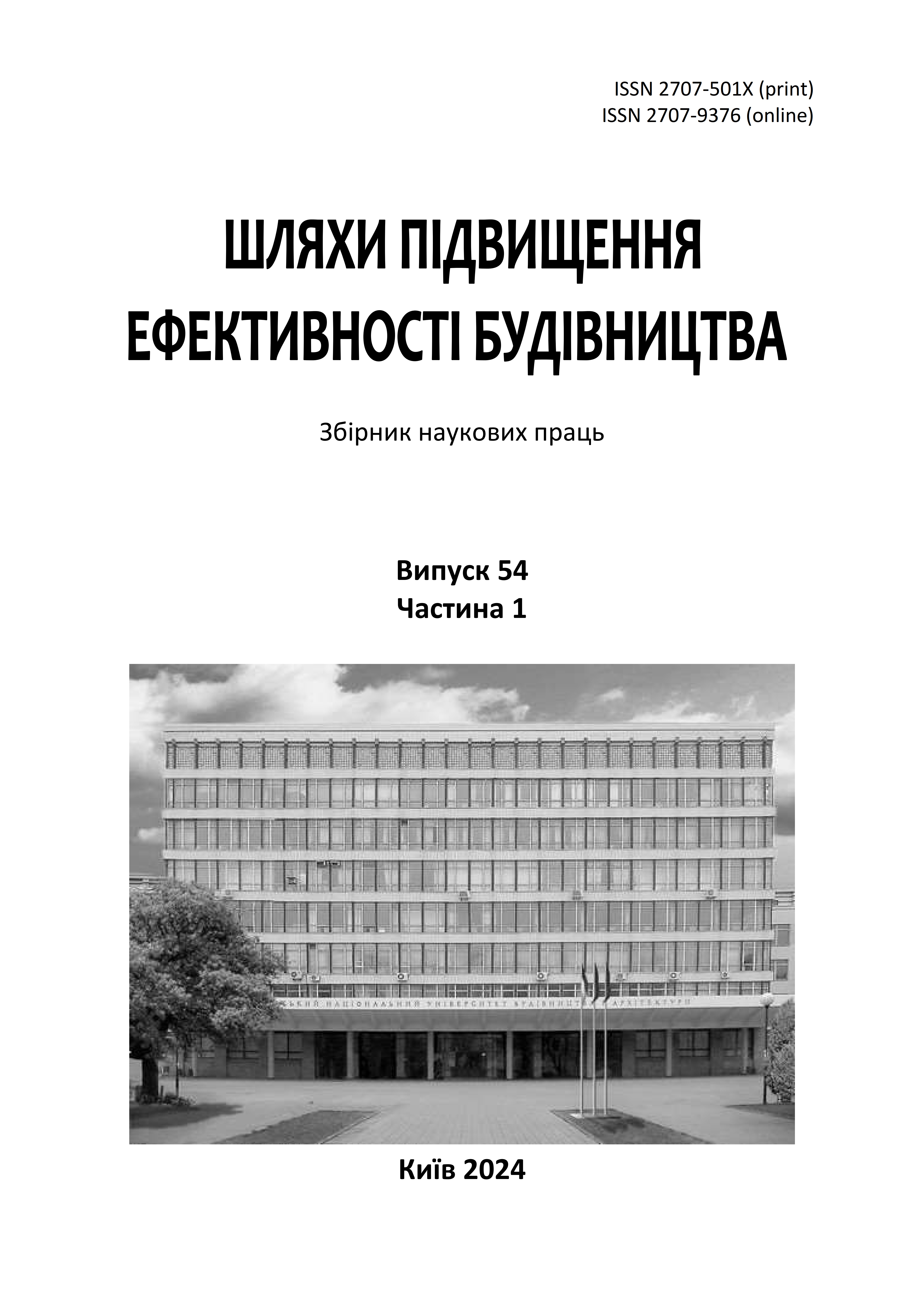Monitoring of indicators and criteria for assessing energy consumption by residential buildings
DOI:
https://doi.org/10.32347/2707-501x.2024.54(1).105-114Keywords:
monitoring, energy efficiency, BIM technologies, energy generation, zero balance of energy consumption, innovative construction, life cycle of the structureAbstract
The scientific article reveals the role of monitoring energy consumption by residential real estate objects throughout the life cycle, which is an integral part of increasing energy efficiency. An analysis of the existing methodology for assessing the energy efficiency of real estate construction has been conducted.
Promising concepts of methods for assessing indicators and criteria for the energy needs of buildings while ensuring comfortable conditions for people to stay in them have been investigated. Studies indicate that the use of a system for continuous monitoring of energy consumption indicators according to energy efficiency criteria provides significant resource savings with a reduction in maintenance costs and operating costs. The prospects for implementing monitoring of energy efficiency indicators are substantiated. The feasibility of an integrated approach to monitoring indicators and criteria for assessing energy consumption, including all stages of the life cycle of buildings and structures, has been proven. The methodology proposed by the author of the article can be applied by an individual energy manager and energy management departments of municipal enterprises, managers of multi-apartment residential buildings.
Considerable attention in energy management work is paid to the collection and analysis of data on the consumption of fuel and energy resources in buildings and structures of the municipal and budgetary sphere, including dormitories of educational institutions of various degrees of accreditation.
At the same time, investors and managers of residential buildings have the opportunity to ensure: correct operation of equipment; creation of an archive of energy consumption data; identification of methods and means for the greatest increase in energy efficiency potential.
The article discloses the use of the "ET-diagram" and "ET-curve" as basic components of monitoring indicators and criteria for assessing energy consumption by residential buildings.
Weekly energy monitoring is recommended for timely detection of unforeseen PER costs and elimination of possible malfunctions. The application of the methodology presented in the article is appropriate for both individual residential buildings and complexes of buildings, blocks, neighborhoods and cottage towns with a centralized PER supply system. Based on the research results, the main principles of monitoring energy consumption indicators have been determined, which contribute to increasing the financial and economic indicators of facilities. The proposed approach to organizing monitoring indicators and criteria for assessing energy consumption by residential buildings allows for a thorough analysis of resource consumption and forecasting the volumes of their use for the future, including the use of BIM technologies.
References
Методика моніторингу енергоспоживання. URL: https://pdf.usaid.gov/pdf_docs/PA00MD8N.pdf
Статистичні дані житлового фонду Держстату України. URL:https://www.ukrstat.gov.ua/operativ/operativ2020/zf/zf_reg/zf_reg21_eu.xls
Перегінець І.І. Кластерні форми організації будівельного виробництва в умовах розвитку соціально-економічних трансформацій сучасної України. Містобудування та територіальне планування. 2017. Вип. 64. С. 560-569.
Савицький М.В., Бендерський Ю.Б., Перегінець І.І., Бабенко М.М. Показники енергоефективності малоповерхових екобудинків з використанням місцевих матеріалів. Строительство. Материаловедение. Машиностроение. Серия: Создание высокотехнологических экокомплексов в Украине на основе концепции сбалансированного (устойчивого) развития. 2011. Вып. 60. С. 168-170.
Савицький М.В., Бендерський Ю.Б., Юрченко Є.Л., Перегінець І.І., Коваль О.О., Бабенко М.М. Світовий досвід енергоефективного будівництва з місцевих матеріалів та доцільність його використання в умовах України. Строительство. Материаловедение. Машиностроение. Серия: Инновационные технологии жизненного цикла объектов жилищно-гражданского, промышленного и транспортного назначения. 2011. Вып. 61. С. 375-381.
Перегінець І.І., Савицький М.В., Куліченко І.І., Коваль О.О. Адміністративно-територіальна реформа в Україні як джерело розвитку малоповерхового житлового домобудування. Строительство. Материаловедение. Машиностроение. Серия: Инновационные технологии жизненного цикла объектов жилищно-гражданского, промышленного и транспортного назначения. 2015. Вып. 82. С. 149-153.
Перегінець І.І., Савицький М.В., Коваль О.О., Бабенко М.М., Пипа В.В. Ефективність інноваційних моделей будівельного виробництва в умовах конкурентного середовища. Строительство. Материаловедение. Машиностроение. Серия: Инновационные технологии жизненного цикла объектов жилищно-гражданского, промышленного и транспортного назначения. 2016. Вып. 91. С. 115-118.
Перегінець І.І., Назаренко І.І., Савицький М.В., Юрченко Є.Л., Коваль О.О., Бринзін Є.В. Синергетичний ефект кластерних домобудівних стратегій житлового сектору України в умовах соціально-економічних трансформацій. Строительство. Материаловедение. Машиностроение. Серия: Создание высокотехнологических экокомплексов в Украине на основе концепции сбалансированного (устойчивого) развития. 2016. Вып. 87. С. 92-97.
Перегінець І.І., Савицький М.В., Юрченко Є.Л., Коваль О.О., Ковтун-Горбачова Т.А., Коваль А.С., Зезюков Д.М., Махінько М.М. Розвиток малоповерхового житлового будівництва україни через житлово-будівельну кооперацію. Строительство. Материаловедение. Машиностроение. Серия: Инновационные технологии жизненного цикла объектов жилищно-гражданского, промышленного и транспортного назначения. 2014. Вып. 77. С. 139-143.
Назаренко М.І.,. Перегінець І.І, Бринзін Є.В. Моделювання структури мобільних комплектів машин для організації технології процесів зведення енергоефективних будинків нового покоління. Строительство. Материаловедение. Машиностроение. Серия: Инновационные технологии жизненного цикла объектов жилищно-гражданского, промышленного и транспортного назначения. 2017. Вып. 100. С. 115-117.
Downloads
Published
How to Cite
Issue
Section
License

This work is licensed under a Creative Commons Attribution 4.0 International License.
Authors who publish with this journal agree to the following terms:
- Authors retain copyright and grant the journal right of first publication with the work simultaneously licensed under a Creative Commons Attribution License that allows others to share the work with an acknowledgement of the work's authorship and initial publication in this journal.
- Authors are able to enter into separate, additional contractual arrangements for the non-exclusive distribution of the journal's published version of the work (e.g., post it to an institutional repository or publish it in a book), with an acknowledgement of its initial publication in this journal.
- Authors are permitted and encouraged to post their work online (e.g., in institutional repositories or on their website) prior to and during the submission process, as it can lead to productive exchanges, as well as earlier and greater citation of published work (See The Effect of Open Access).

